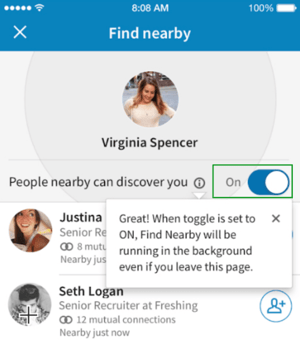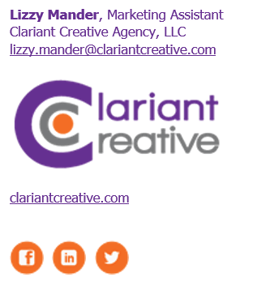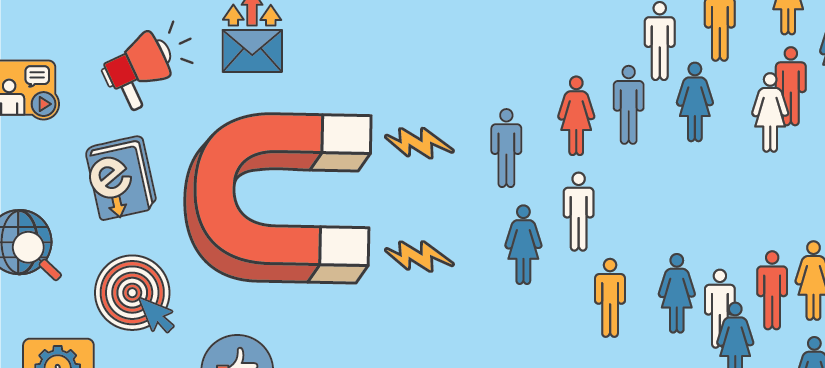How to Get the Most out of a Business Networking Event

Networking: Everyone has their own opinion on it. Regardless if you love it or hate it, networking is important to any marketer’s success. Through networking, you can develop a new skill set, stay on top of trends, and meet new potential clients or business partners.
However, business networking events are only as beneficial as you make them. While it may seem hard to make small talk with strangers when you have plenty of other tasks on your to-do-list, getting the most out of each networking event is easier than you may think.
Continue reading to improve your networking skills and learn what to do at your next networking event.
Before the Event: How do I prepare for a business networking event?
When you were in school, you knew if you didn’t do your homework, you wouldn’t be ready for the test. Similarly, if you don’t prepare your networking material in advance, you won’t be ready for the event. Preparing is the key to making sure your networking experience runs smoothly and confidently.
Create an elevator pitch
An elevator pitch is a succinct and persuasive introduction. Imagine you are selling yourself each time you start an introduction. You want to present the best and most important information to your potential connections.
Your elevator pitch should be 30-60 seconds long (the time it takes to ride an elevator) and should include:
- Your name: Introduce yourself
- What you do: Job title and brief description
- What you’ve done: Specific accomplishment in current role
- What is your objective: Why are you here?
- Personal why: What is your mission/goals in life?
But, how do you know when to use your elevator pitch?
Many networking events begin by having everyone introduce themselves, requiring you to state where you work and what you do. This is a great circumstance in which your full elevator pitch will be perfect to use. However, if you’re at an event where people are talking and mingling in a more informal manner, a more casual version of your pitch may be more appropriate.
An example of a strong elevator pitch looks something like this:
“Hi, my name is Mary, and I am the Marketing Manager at Dream Agency, where I work with clients to help them improve their marketing strategy. Over the past year, I have helped my agency increase our clients’ annual revenue by 25%. If your company is in need of help growing revenue, I’d be more than happy to help.“
Once you’ve spent some time developing and polishing your elevator pitch, it’s time to practice. You won’t look professional if you’re stumbling over your words. Save yourself the stress by making sure you arrive at the networking event with your elevator pitch memorized and practiced. Sound like a human, not a robot.
Pack supplies
Each networking event is different, and you never know what kind of supplies they will have available to you once you arrive. It’s better to be safe than sorry by bringing all the appropriate materials you’ll need.
Every marketer should bring a notepad, pen, or an electronic note-taking resource, such as an iPhone or iPad with the app Evernote, to a networking event. You’re bound to need to take notes at some point in the event, whether it’s ideas you want to remember from the guest speaker’s presentation, contact information from a great new connection, or even little reminders to yourself.
Also, bring plenty of business cards. Imagine this: You meet the perfect potential client and reach into your bag to hand out your business card—but then realize you just gave your last one away. Avoid this situation by bringing more business cards than you could possibly need.
Pro tip: Don't have your business cards with you? Use the LinkedIn app on your phone to connect with people right away. Take it a step further with LinkedIn’s “Find nearby” feature. To use this, make sure your phone’s bluetooth is on, tap “My Network,” and tap “Find nearby” at the top of the screen. From there, you can easily connect with other folks in the room.

Source: LinkedIn Help – Using the find nearby feature
Set a goal
According to Inc., you are 42% more likely to achieve your goals if you write them down. Before arriving at the event, set a goal for yourself. This will help you stay focused and will give you something to actively work toward at the event.
Possible networking goals to set for yourself might include:
- Start a conversation with 5 new people.
- Hand out business cards to 3 new people.
- Make 5 new connections on LinkedIn.
- Learn something new.
- Take action on something that moves you.
Don’t allow yourself to leave the networking event unless you have reached your goal! You’ll leave feeling accomplished, and you’ll have made sure attending the event was worth the time and money.
Arrive early
It’s embarrassing to walk in late only to find limited open seats available. Give yourself enough time to arrive to the networking event 10-15 minutes before the scheduled start time. By arriving early, you’ll get to choose where you want to sit, scope out the venue, and even start connecting with people.
At the Event: How do I talk to people at business networking events?
Networking events can be filled with potential clients and helpful connections to expand your professional network. By knowing who to talk to and what to say, attending networking events will become easier and much more beneficial.
Find ways to resonate with others. Ask questions that you genuinely care about. Look for ways to add value to the conversation. Make connections with people.
Be aware of body language
You make a first impression within the first seven seconds of meeting someone, so start off strong. The way you present yourself can make you appear confident, approachable, friendly, mean, or nervous. Understand and use the right body language to show the best version of yourself.
Focus on these body language techniques:
|
Source: GIPHY |
|
|
Source: GIPHY |
No crossed arms or legs – Avoid talking to people with crossed arms or legs, which can signal discomfort and disagreement. Instead approach people who are open and relaxed. |
|
Source: GIPHY |
Eye contact – Find a happy medium when it comes to eye contact. To show you’re listening and engaged, eye contact is necessary — but too much eye contact can make the people you’re speaking with feel uncomfortable. |
|
Source: GIPHY |
|
Educating yourself on body language cues will not only make yourself more approachable, but it will allow you to naturally continue a conversation (with as little awkwardness as possible).
Find people to talk to
It takes more than just body language to boost your professional networking. To create connections, you need to find people to talk to. Get the most out of each event by learning how to speak to as many people as possible.
When the guest speaker at an event is giving their presentation, keep mental notes on who you could possibly introduce yourself to. A great place to start is with the people who are asking questions during the presentation. Finding the extroverts at an event is a great way to find talkative and easy people to introduce yourself to.
“If someone is brave enough to ask a question in front of the entire room, chances are, they would be more than willing to have a conversation with you.”
–Krista Elliott, Clariant Creative Agency
Another great person to strike up a conversation with is the guest speaker. While this may seem intimidating, speakers are often experts in their field and could be a helpful connection to have in your network.
Finally, look for the people who also seem to have no one to talk to. Maybe they just arrived, or maybe they are too introverted to try to join a new conversation. Either way, chances are they would be grateful that you struck up a conversation with them. That’s why people are there, right?
Ask the right questions
Once you’ve identified someone to talk to, what are you supposed to say? We’ve asked our team of inbound marketing specialists to share their go-to networking icebreakers:
Beth Carter
- “What did you think of the speaker?”
- “Do you attend these events often?”
- “What brought you here today?”
- “What do you do?”
“People love to talk about themselves, so ask questions to encourage that. Questions about why they’re here, what they do, or what they think are great ways to get the conversation rolling.”
 Krista Elliot
Krista Elliot
- “I overheard _______ earlier. I’m not familiar. Do you mind explaining what this and what it’s about?”
“Use networking as a way to gain valuable information. You don’t have to act like you understand everything. Asking questions on new topics allows you to learn more and have a quality conversation.”
- “I like your bag, where did you get it?”
“It’s not difficult to find at least one nice thing to say about someone. Starting a networking conversation can be as simple as complementing one’s bag, hair, outfit, etc.”
 Caitlin Sellers Castevens
Caitlin Sellers Castevens
- “How can I support you?”
- “Can I join this conversation?”
“Waste no time by simply asking to join the conversation. The worst they can say is no.”
Know when to find a new conversation
We attend networking events to find connections that will benefit our network, but sometimes we need a graceful way to end a conversation and move on to meet new people. It is important to recognize when someone is not a good fit for your network so you can spend your networking time wisely.
Now comes the tricky part: ending the conversation. Come prepared with excuses ready to use to politely get out of a conversation. Don’t be afraid to keep it (respectfully) real.
Some examples include:
- “Have you seen the restroom?”
- “I’m going to grab some water. Would you like some?”
- “It was great connecting today. I’d love to meet a few more people before I leave.”
- “You should meet Mike, he mentioned the same thing earlier!”
Pro Tip: Introduce people to each other and help other people expand their connections to supercharge your networking abilities!
After the Event: What do I do after the business networking event?
“Not following up with your prospects is the same as filling up your bathtub without first putting the stopper in the drain.” –Michelle Moore, author of Selling Simplified
Great, you’ve talked to many new people, handed out and received many business cards, and learned valuable information. Maybe you even found a potential client or met another marketer just like you. But, all of that means nothing without following up in a timely, relevant way to solidify the relationship.
Acquire contact information
It’s impossible to send a follow-up if you don’t have any way to do so. Before leaving a networking event and ending a conversation with a potential connection, exchange business cards, write down their contact information, or connect on LinkedIn to stay in touch easily.
Follow up in a timely manner
As a general rule of thumb, you should ideally follow up with your new connections within 24 hours, or at the very latest, two business days after the event. Being timely keeps you top of mind for your new connection. Your follow-up might include writing an email, sending a LinkedIn direct message, or scheduling a phone call.
Personalize follow-ups
Kick your follow-ups to the next level by personalizing them. Make your potential new network feel valued by showing you genuinely listened to them at the event. Instead of simply connecting on LinkedIn, go the extra mile and personalize the connection request. Instead of sending a basic, generic email, send a customized email highlighting an interesting thing you talked about.
Consider these two versions of networking follow-up emails:
 Message #1:
Message #1:
Good afternoon, my name is Lizzy and we met at the event the other day. Check out my recent blog post.
Best,
Lizzy

 Message #2:
Message #2:
Hi, Susan!
It was great to meet you this past Tuesday at the Madison Conference Center Networking Event. I loved hearing about how you’re using LinkedIn advertisements. If you have the time, I’d love to meet for coffee and continue the conversation!
Best,
Lizzy

Clearly, message #2 is the winner. This personalized message reminds the recipient of the date and location of the event where you met, what you talked about, and an invitation to continue the conversation.
On the other hand, message #1 fails to even use the first name of recipient and focuses on self-promotion instead of focusing on a mutually beneficial connection.
3 Stages To Get the Most out of a Business Network Event
Networking events provide an amazing opportunity to make new connections, increase your customer base, and learn new skills. And the good news is that all of this is easier than it may seem.
Simply break your networking strategy down into three stages:
- Pre-event: preparing in advance
- Live event: finding people to talk to and asking the right questions
- Post-event: following up with your new connections
“Networking is marketing. Marketing yourself, your uniqueness, what you stand for."
–Christine Comaford-Lynch, best-selling author and CEO of SmartTribes Institute
No one has time to waste at marketing network events. Follow these tips to help you stand out and become a networking pro, and make every networking event worth your time.






![Great Sales Emails That Convert [TEMPLATES]](https://www.clariantcreative.com/hubfs/blog-images-2018/email-templates.jpg)